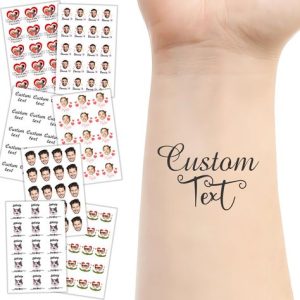Finger tattoos are a popular choice for their bold look and ability to express yourself in a small space. However, their placement on frequently used hands means they may not last as long as tattoos on other parts of your body. This article explores the factors affecting finger tattoo longevity and how to care for them to maximize their lifespan.
Why Do Finger Tattoos Fade Faster?
Finger tattoos fade faster than tattoos on other areas for several reasons:
High Turnover:
Skin on your fingers is constantly regenerating. This rapid cell turnover pushes out tattoo ink, causing the tattoo to fade quicker.
Friction:
Hands are used constantly, rubbing against objects and washing them with soap. This friction wears away at the tattoo ink over time.
Exposure:
Fingers are exposed to sunlight more than some body parts. Sun exposure can break down tattoo ink, accelerating fading.
Consider these factors before getting a finger tattoo.

How Long Do Finger Tattoos Typically Last?
It’s difficult to predict exactly how long a finger tattoo will last. Several factors influence fading:
-
Individual Skin: Everyone’s skin regenerates at a different rate. Oily skin might hold onto ink better than dry skin.
-
Tattoo Technique: A skilled tattoo artist using proper technique deposits ink deeper into the skin, potentially leading to slower fading.
-
Lifestyle: Frequent handwashing, manual labor, and sun exposure can accelerate fading.
Generally, expect tattoos to show noticeable fading within 6 months to a year.
Extending the Life of Your Finger Tattoo
While fading is inevitable, you can take steps to slow it down:
-
Choose a Skilled Artist: An experienced artist uses proper technique to place ink at the right depth for better longevity.
-
Moisturize Regularly: Dry skin can crack and cause ink loss. Use a fragrance-free lotion to keep hands hydrated.
-
Sun Protection: Wear sunscreen on your hands daily to prevent sun damage that can break down ink.
-
Mind Your Habits: Avoid harsh chemicals, excessive handwashing, and activities that rub your fingers excessively.
Proper care can extend the life of your finger tattoo.

Alternatives to Finger Tattoos
If fading is a major concern, consider alternative tattoo placements:
-
Wrist Tattoos: The wrist is a popular choice that offers more visibility and durability than tattoos.
-
Hand Tattoos: Hand tattoos offer more space for intricate designs and may fade slower than finger tattoos.
-
Ankle Tattoos: Ankle tattoos are a discreet option that offer good longevity.
Discuss alternative placements with your tattoo artist.
Finger tattoos can be beautiful and meaningful. However, they require special care and may fade faster than tattoos on other areas. Consider your lifestyle, budget, and tolerance for touch-ups before making a decision.
The Fickle Fade of Finger Tattoos
Finger tattoos are known to be high-maintenance due to their tendency to fade faster than tattoos on other parts of the body. This fading is caused by several factors:
-
Skin Turnover: The skin on your fingers regenerates quickly, pushing out tattoo ink over time.
-
Friction City: Our hands are constantly in use, rubbing against things and getting washed. This friction wears away at the tattoo ink.
-
Sun Exposure: Fingers are more exposed to sunlight than some areas, and sunlight can break down tattoo ink.
These factors can cause noticeable fading within 6 months to a year for finger tattoos.
Here are some additional things to consider:
-
Everyone’s Different: Skin regenerates at varying rates, so how quickly your tattoo fades depends on your own body.
-
Tattoo Artist Matters: A skilled artist uses proper technique to place ink deeper for better longevity.
-
Lifestyle Choices: Frequent handwashing, manual labor, and sun exposure can accelerate fading.
If you’re considering a finger tattoo, it’s important to be aware of the potential for fading and be prepared for touch-ups to maintain the design.

Understanding Finger Tattoos:
Finger tattoos have gained popularity in recent years due to their subtle yet stylish appeal. Unlike tattoos on other parts of the body, finger tattoos are more prone to fading and distortion over time. The unique characteristics of finger skin, such as its thinness and constant movement, contribute to the challenges of maintaining tattoo integrity.
Factors Affecting Longevity:
Several factors influence the lifespan of finger tattoos. Firstly, the quality of the ink and the skill of the tattoo artist play significant roles. High-quality ink and precise application can prolong the vibrancy of the tattoo. Additionally, individual skin type and lifestyle choices, such as exposure to sunlight and frequent hand washing, can impact tattoo longevity.
Ink Types and Techniques:
Choosing the right type of ink and tattooing technique can enhance the durability of finger tattoos. Traditional black ink tends to hold up better over time compared to colored ink, which may fade more quickly. Techniques such as dotwork or fine line tattooing can also help maintain the intricate details of finger tattoos for longer periods.
Aftercare Practices:
Proper aftercare is crucial for preserving the quality of finger tattoos. Following the tattooing process, it is essential to keep the area clean and moisturized to promote healing. Avoiding exposure to harsh chemicals and excessive sunlight can prevent premature fading and distortion of the tattoo.
Touch-Up Procedures:
Despite best efforts, some fading and distortion of finger tattoos may occur over time. In such cases, touch-up procedures can help restore the tattoo’s appearance. Tattoo artists can carefully retrace the design and add fresh ink to areas that have faded, extending the lifespan of the tattoo.
Long-Term Maintenance:
To maximize the longevity of finger tattoos, ongoing maintenance is key. Regular touch-ups, moisturizing, and sun protection can help preserve the integrity of the tattoo for years to come. Additionally, being mindful of activities that may cause excessive friction or trauma to the tattooed area can prevent premature wear and tear.
In conclusion, the durability of finger tattoos depends on various factors, including ink quality, tattooing technique, and aftercare practices. While finger tattoos may require more maintenance compared to tattoos on other body parts, proper care can significantly extend their lifespan. By understanding these factors and implementing effective maintenance strategies, individuals can enjoy their finger tattoos for years to come.


